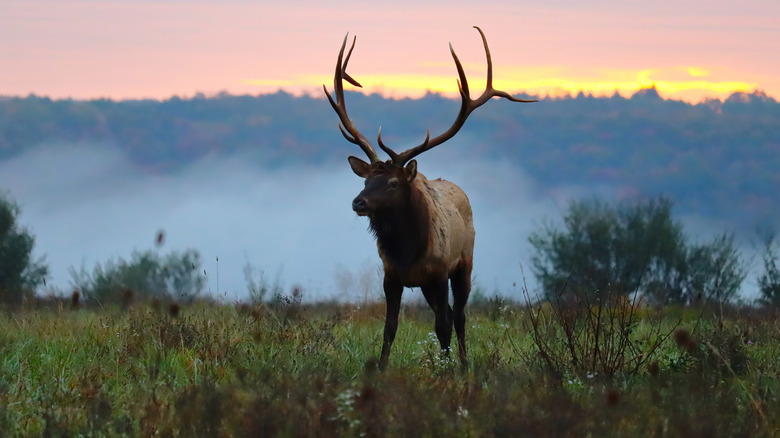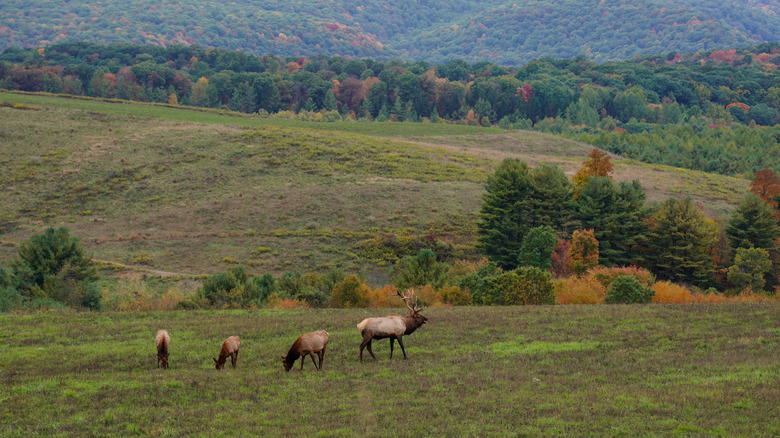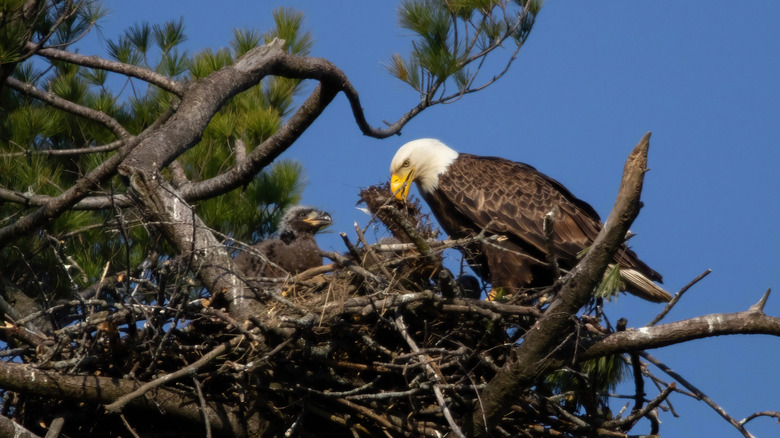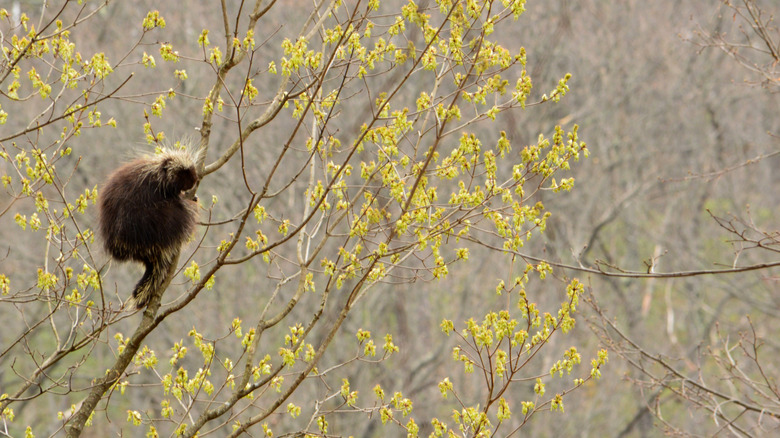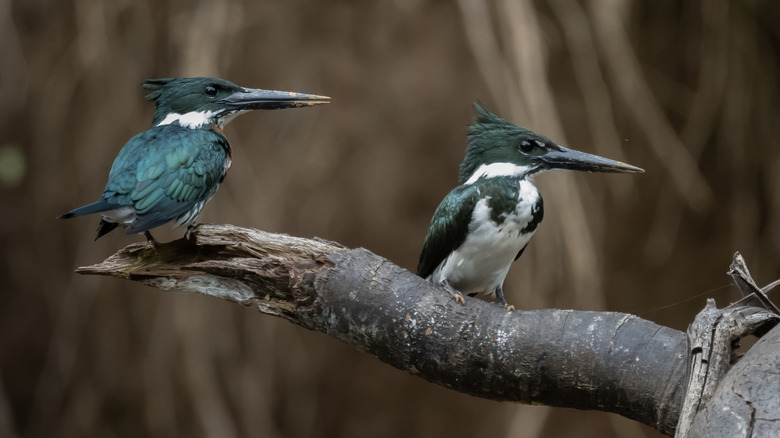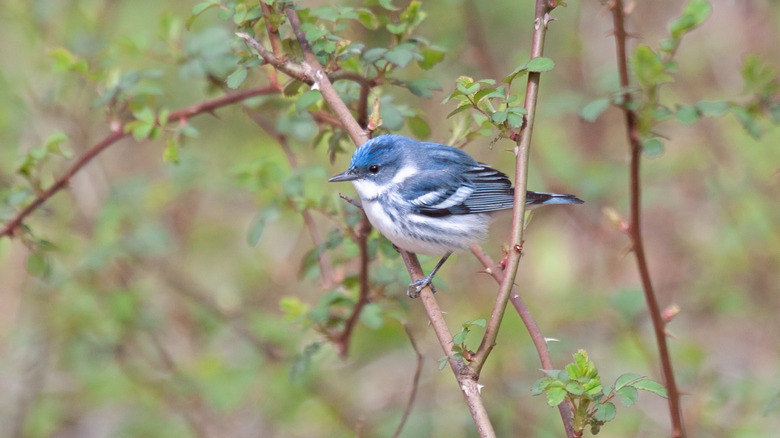The Best Parks To Visit In Pennsylvania If You Love Watching Wildlife
When considering some of the best places for watching wildlife on the East Coast, most people would probably think of some of those famous eastern national parks or heavily forested areas like the Blue Ridge Mountains and Adirondacks. However, what most people don't realize is just how much nature and wildlife viewing opportunities there are in Pennsylvania. In fact, Pennsylvania contains 124 different state parks that are full of animals and give visitors the opportunity to spot a range of beautiful creatures from bears, deer, otters, and elk to eagles, hawks, bobcats, wild turkeys, and porcupines.
Pennsylvania is known for its elk herds in particular, and even has a 127-mile long wilderness road known as the Elk Scenic Drive which passes through forests and wilderness of five different counties. The Elk Scenic Drive also includes plenty of great stopping places where travelers can get out of their car and see the elk herds in person or get more information about these beautiful animals at the Elk Country Visitors center. On top of this fantastic scenic drive, there are also many wonderful state parks in Pennsylvania that are perfect for people looking to catch a glimpse of the abundant local wildlife.
Sinnemahoning State Park
Located around a 20-minute drive north of the Elk Scenic Drive road, Sinnemahoning State Park is a great pitstop if you are looking to get out and stretch your legs while also getting the chance to spot more elk and wildlife on the way. Sinnemahoning State Park is a great stop for the whole family and has an informative visitor center which, as one reviewer on TripAdvisor noted, "is very kid friendly with some interactive activities and cool tunnel to crawl in." If that's not all, they also explained that, "[The park has] some informational stuff for kids involving animals and history of Sinnemahoning."
Then, once you've learned your fill at the visitors center, you can drive through the park or explore the grounds on foot looking for some of the area's abundant wildlife. Spot the park's small but growing herd of elk as they graze near the wildlife viewing platform, 40 Maples Picnic Area, or the wildlife center. Then, walk the trails to try and spot other beautiful wild animals like bald eagles, black bears, coyotes, bobcats, and even the rare snowy owls in winter. The most popular trails at this state park are the short and sweet Sinnemahoning Red Spruce Trail and the slightly longer Low Lands Trail. Just remember to view all wildlife responsibly and safely and keep your distance. It is typically recommended to maintain around 100 yards of space between you and an elk, and it's a good idea to do the same with all wildlife.
Bald Eagle State Park
Located in north central Pennsylvania, around a 20-minute drive from the town of Snow Shoe which marks the eastern end of the Elk Scenic Drive, Bald Eagle State Park is a great wildlife viewing stop either at the beginning or end of your journey down this beautiful highway. Bald Eagle State Park is a 5,900-acre area of wilderness that surrounds Bald Eagle Mountain. This park contains over 14 miles of hiking trails that you can explore to try and spot wildlife. Birders looking for bald eagles or waterfowl like heron, osprey, migrating mergansers, and cormorants often head to the lake with a pair of binoculars to see what they can find.
If you'd like to try and spot a porcupine or a wild turkey, then you can take a walk through the hickory and oak forests of Bald Eagle Mountain. The trail up to the top of the mountain is also popular among birders. It is considered a challenging yet fun route. As one reviewer on AllTrails described traversing the trail, "[It] felt like a movie. Tons of water crossings with downed trees to pave the way. True adventure here." If you want to stay the night, you can also check out the onsite Nature Inn, which offers beautiful views of the forest-covered hills and was named one of the 10 best eco-friendly hotels by USA Today in 2021.
Quehanna Wildlife Area
If you are serious about wildlife viewing and photography, then there is no better place in the Keystone State than the Quehanna Wildlife Area. Spanning an area of around 50,000 acres, Quehanna Wildlife Area is home to coyotes, bobcats, elk, deer, and black bears. It was also named an important birding area by the Pennsylvania Audubon Society and some hikers even claim to have spotted the elusive barred owl in Quehanna.
This park can easily be explored by car or on foot on some of the 75 miles of hiking trails. Part of the Elk Scenic Drive highway passes through the beautifully remote wildlife reserve and grants travelers access to many of the trails through the forests — the Teaberry, Lincoln, and Beaver Run Loop is a great choice for a moderate two-hour hike with great views. If you are a thru-hiker or backpacker, you may be interested in the multi-day 72.6-mile Quehanna Trail, which is one of the trails in Pennsylvania where you are most likely to spot elk or at least hear them bugle off in the distance during rutting season. Reviewers on AllTrails mentioned the Quehanna Trail taking them between three and five days to complete, with one reviewer specifically warning, "It is bear country so bring a bear bag." Knowing the correct way to store your food while camping is very important when sleeping or hiking in bear country.
Cook Forest State Park
Although not connected to the Elk Scenic Drive, if you are visiting northwestern Pennsylvania, then Cook Forest State Park is a great stop for wildlife viewing. Also known as the Black Forest of Pennsylvania, Cook Forest State Park covers an area of 8,500 acres, 2,300 of which are made up of beautiful old growth forests dating back to the 1500s. Of the 11 old growth areas in the state park, the Forest Cathedral Natural Area is the most famous and contains huge white pine and hemlock trees, some of which reach a height of 200 feet.
In such a gorgeous old growth forest, it comes as no surprise that there is tons of wildlife to be seen at Cook Forest State Park. Cook Forest was also named an important bird area by the Audubon society and is home to bald eagles, blue herons, and kingfishers. The park contains many other interesting animals as well, including foxes, coyotes, deer, porcupines, otters, wild turkeys, and black bears. In fact, Cook Forest is a well-known black bear hotspot and hikers and campers in the area are strongly advised to keep their food stored in airtight containers inside a vehicle. This is important because bears that have been fed by humans can become more aggressive and dangerous. Although it is unlikely, it is good to know what to do if you are ever attacked by a bear if you plan to spend time in bear country.
Raccoon Creek State Park
Located only around a 35-minute drive from Pittsburgh, Raccoon Creek State Park is a great wildlife viewing option if you are visiting the city and don't have time to head out into the center of the state near the Elk Scenic Drive area. This state park is famous in particular for its wildflowers which bloom twice a year (once between April and May and once again between August and September) and attract all kinds of beautiful animals from pollinators like butterflies to beautiful birds like warblers. In fact, Raccoon Creek State Park is home to many endangered species including eastern spadefoot toads, Indiana bats, sharp-shinned hawks, red-shouldered hawks, cerulean warblers, bobcats, and black bears.
Plus, for birders, there is even more to see in this state park than the rare cerulean warblers. In fact, many birders head to the Hocking Valley Birding Trail to look for other hard-to-find birds like pileated woodpeckers, red-headed woodpeckers, and purple finches. There are also other varieties of warblers that call this park their home. If you are looking for wading birds and shorebirds, you will find them fishing and nesting in the marshy area around Raccoon Creek.
